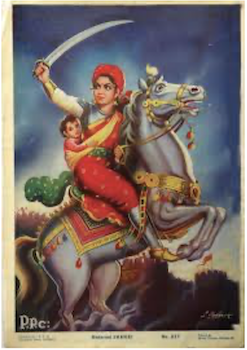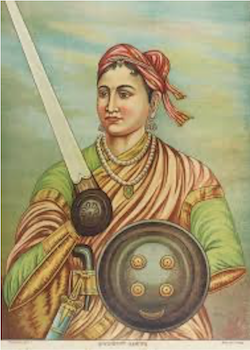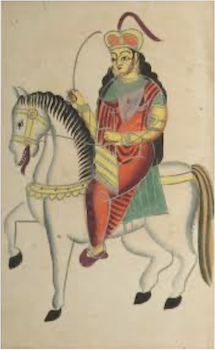
Rani Lakshmi Bai was born as Manikarnika Tambe in November 1828. She belonged to a traditionally Brahmin, or high social class, family in Varanasi, a city in Uttar Pradesh, India. Her father, Moropant Tambe, was an army commander for Peshwa Baji Rao, the last ruler of the Maratha Empire. As a result of her high social class and her father’s military presence, much of her upbringing was uncommon, especially for girls of the time period. She spent her childhood shooting arrows, fencing, and riding horses alongside her childhood friends. Manikarnika was also educated at home and could read and write her mother tongue of Marathi–another uncommon practice for girls in India.
In May 1842, at age 14, Manikarnika was married to the Maharaja, or King, of Jhansi, Gangadhar Rao. Jhansi is located in modern day Uttar Pradesh, India. As per tradition, she was renamed Lakshmi Bai, after the Hindu Goddess of wealth. In 1851, she gave birth to a boy, Damador Rao, who died after four months. Lakshmi Bai and her husband later adopted a son and affectionately named him Damador Rao, in honor of their late son. This adoption was conducted in the presence of the British officer, Captain Alexander Skene. A letter was given to Skene from the Maharaja stating that Lakshmi Bai should be given the throne in the case of the Maharaja’s death. The Maharaja passed away in November 1853, leaving behind Lakshmi Bai and their adopted son. The British refused to recognize the authority of Lakshmi Bai and annexed Jhansi. Instead, they ransacked the palace and evicted the queen and her son out of their home.

In 1857, an uprising against the British occurred, sparked by unfair treatment of native Indians. The Indian Mutiny was a widespread rebellion against the British East India Company, which at the time, owned about two-thirds of the Indian subcontinent. Accordingly, the East India Company attempted to develop the Indian economy and its legal system. These laws were superimposed; they did not take into account the cultural and religious systems that native Indians lived in. Many Hindus were also afraid of forced conversion to Christianity. News of this rebellion reached Lakshmi Bai, who formed her own militia group for protection against the Indian troops. Since Jhansi was a British fort, Lakshmi Bai and her son were in danger because they were associated with the British crown. The Indian resistance seized the Fort of Jhansi and massacred the British. Whether or not Lakshmi Bai had anything to do with it remains disputed, but the British believed Lakshmi Bai to be the reason for the siege of its people. In March 1858, British soldiers arrived at Jhansi and found it well defended. The Queen and her army fought bravely against the British, but Lakshmi Bai soon realized that her small militia was no match for the endless British force. The British invaded and massacred the entire population of Jhansi on April 4, 1858. Lakshmi Bai, along with her son and a few guards managed to escape east to Kalpi where they met up with the main rebellion army.

Rani Lakshmi Bai continued to fight with the Indian rebellion and successfully captured the fort of Gwalior, along with other rebel soldiers. On June 17, 1858, near Phool Bagh of Gwalior, British forces attacked rebel forces led by Lakshmi Bai. She rode into battle dressed as a soldier with her son tied on her back. The Queen was fatally wounded in battle, but managed to find refuge in a secluded area. She gave her son to a trusted general and made sure he would be well taken care of after her passing. Lakshmi Bai did not want the British to get ahold of her body, and ordered it to be cremated after her death. She passed away the next day, June 18, 1858, at age 29. Her tomb lies in Phool Bagh Maidan, Gwalior, India.
Despite western audiences not knowing Lakshmi Bai’s name, the country which she fought for, India, honors her in many ways. Her legacy is showcased through many different mediums of art such as movies, books, and statues. One example of a popular Bollywood movie is Manikarnia: The Queen of Jhansi. Lakshmi Bai is an inspiration and a role model to young Indian women. Lakshmi Bai is the face of the Indian Rebellion, and is remembered as a brave and courageous woman.
Why Did I Choose to Research Rani Lakshmi Bai?
I chose to research Rani Lakshmi Bai because she is one of the only known female Indian freedom fighters. Being Indian living in America, I only ever heard about Gandhi in the media, never other brave people, particularly women, who fought for India. Having Indian representation in the media is important to me because, growing up, I never saw role models who looked like myself and came from the same background as me. I am excited to be bringing light to Lakshmi Bai.
Works Cited
Beckford, C. (2024, March 8). The Warrior Queen: Lakshmibai, the Rani of Jhansi – The Gale Review. Retrieved from review.gale.com website: https://review.gale.com/2024/03/08/the-warrior-queen-lakshmibai-the-rani-of-jhansi/
glasgowmuseums2018. (2022, March 1). The Rani of Jhansi, a symbol of resistance to British Rule in India. Retrieved from Legacies of Slavery in Glasgow Museums and Collections website: https://glasgowmuseumsslavery.co.uk/2022/03/01/the-rani-of-jhansi-a-symbol-of-resistance-to-british-rule-in-india/
Javaid, A. (2020, June 18). Rani Lakshmibai Biography: Birth, Family, Life History and Death. Retrieved from Jagranjosh.com website: https://www.jagranjosh.com/general-knowledge/rani-lakshmibai-biography-1592467437-1
Lakshmi Bai | Biography, Image, & Facts | Britannica. (2019). In Encyclopædia Britannica. Retrieved from https://www.britannica.com/biography/Lakshmi-Bai
Press, C. (n.d.). Rani of Jhansi Lakshmi Bhai, late 19th century-early 20th century by Chitrashala Press. Retrieved July 27, 2024, from www.artgallery.nsw.gov.au website: https://www.artgallery.nsw.gov.au/collection/works/107.2011/
Rani Lakshmi Bai - The Indian Freedom Struggle [Modern Indian History For UPSC]. (n.d.). Retrieved July 21, 2024, from BYJUS website: https://byjus.com/free-ias-prep/ncert-notes-rani-laxmibai-rani-of-jhansi/#:~:text=At%20the%20age%20of%2014
This article was published on 9/11/24